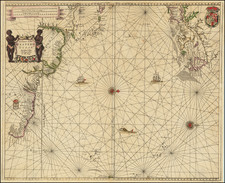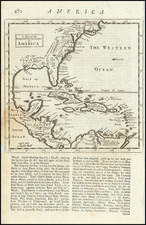Extremely rare and highly detailed map of the Eastern part of North America, extending from from Florida to Newfoundland to Lake Michigan, and the Mississippi River, which appeared in Francois-Antoine Chevrier's Le Point d'Appui entre la Holland et l'Angleterre , et la réponse à la fameuse lettre de Londres du 5. janvier 1759, published in volume one of Mémoires, Nouveaux, pour servir à l'histoire de notre temps in Frankfurt in 1759.
The fascinating map illustrates the disputed areas between the British and French in North America at the height of the French & Indian War (1756-1763). At the time that the map was printed the outcome of the war still hung in the balance, as it was only at the end of the year that news reached Europe that the British had conquered the French American capital, Quebec City, in October 1759. The land disputes portrayed in New England and the Canadian Maritimes were among the route causes of the conflict, which resulted in a decisive British victory. Chevrier, who was naturally a French partisan, delineated the archaic British claims, and referred to them as "pretensions".
The map illustrates the following disputed boundaries with various symbols:
- The current boundaries of the "pretension" of the English are marked ---------
- The boundaries set according to Peace of Utrecth are marked xxxxxxxx
- The "Would be" boundaries established in the Charter of James I in 1621 are marked .........
- The boundaries according to the charter of Cromwell in 1656 are marked ======
The map showcases eastern North America from an extraordinary perspective, with the landmass presented at a sharp angle. The map is vastly detailed, especially for a work if its size, and includes the four lower Great Lakes, while Florida is curiously delineated.
Francois-Antoine Chevrier was a French Satirist and Theatrical Writer, who evidently took great interest in the conflict which was the seminal global event of the period.









![(Colonial New England Ironworks) [Early 19th-century manuscript copy of 1674 New England land transaction involving John Gifford; mention of early ironworks in Massachusetts]](https://storage.googleapis.com/raremaps/img/small/93113.jpg)

![Partie De L'Amerique Septent? Qui comprend La Nouvelle France ou Le Canada . . . [Large Great Lakes Inset]](https://storage.googleapis.com/raremaps/img/small/48752.jpg)

![[ Death of a Florida Indian Chief ] Ceremoniae in Regis & Sacerdotum funere observatae. XL.](https://storage.googleapis.com/raremaps/img/small/97768.jpg)
